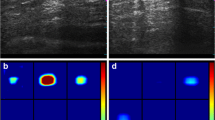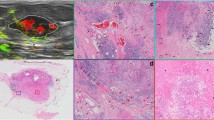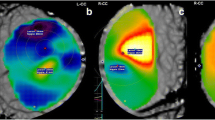Abstract
Objective
To investigate the feasibility and clinical efficacy of ultrasound (US)-guided diffused optical tomography (DOT) in differentiating malignant breast lesions from benign lesions.
Material and methods
From October 2007 to August 2008, 198 women with 214 lesions scheduled for open biopsy were included in this study. Conventional US was used to locate the breast lesion, and DOT to measure the total haemoglobin concentration (THC) for each breast lesion. Sensitivity, specificity and overall accuracy were determined with surgical pathology as the gold standard.
Results
There were 96 benign lesions and 118 malignant lesions. The total haemoglobin concentration (THC) of all 214 lesions was calculated from DOT. The average THC in benign lesions was 125.5 ± 83.4 µmol/L, and in malignant lesions 222.2 ± 87.2 µmol/L. The THC of malignant lesions was significantly higher than that of benign lesions (p < 0.05). When a THC of 140 µmol/L was used as the cutoff value for differentiating breast cancer from benign lesions, the sensitivity, specificity, accuracy, positive predictive value and negative predictive value of DOT were 83.9%, 66.7%, 76.2%, 75.6% and 77.1%, respectively. Our study demonstrated that THC was significantly higher in malignant lesions than in benign lesions.
Conclusion
US-guided diffused optical tomography, a noninvasive functional imaging technique, has potential utility in differentiating breast cancer from benign lesions.







Similar content being viewed by others
References
Ntziachristos V, Chance B (2001) Probing physiology and molecular function using optical imaging: applications to breast cancer. Breast Cancer Res 3:41–46
Zhu Q, Huang M, Chen N, Zarfos K, Jagjivan B, Kane M, Hedge P, Kurtzman SH (2003) Ultrasound-guided optical tomographic imaging of malignant and benign breast lesions: initial clinical results of 19 cases. Neoplasia 5:379–388
Zhu Q, Kurtzma SH, Hegde P, Tannenbaum S, Kane M, Huang M, Chen NG, Jagjivan B, Zarfos K (2005) Utilizing optical tomography with ultrasound localization to image heterogeneous hemoglobin distribution in large breast cancers. Neoplasia 7:263–270
Zhu Q, Cronin EB, Currier AA, Vine HS, Huang M, Chen N, Xu C (2005) Benign versus malignant breast masses: optical differentiation with US-guided optical imaging reconstruction. Radiology 237:57–66
Athanasiou A, Vanel D, Fournier L, Balleyguier C (2007) Optical mammography: a new technique for visualizing breast lesions in women presenting non palpable BIRADS 4–5 imaging findings: preliminary results with radiologic-pathologic correlation. Cancer Imaging 28:34–40
Brooksby B, Pogue BW, Jiang S, Dehghani H, Srinivasan S, Kogel C, Tosteson TD, Weaver J, Poplack SP, Paulsen KD (2006) Imaging breast adipose and fibroglandular tissue molecular signatures by using hybrid MRI-guided near-infrared spectral tomography. Proc Natl Acad Sci U S A 103:8828–8833
Srinivasan S, Pogue BW, Jiang S, Dehghani H, Kogel C, Soho S, Gibson JJ, Tosteson TD, Poplack SP, Paulsen KD (2003) Interpreting hemoglobin and water concentration, oxygen saturation, and scattering measured in vivo by near-infrared breast tomography. Proc Natl Acad Sci U S A 100:12349–12354
Zhu Q, Chen NG, Piao D, Guo P, Ding X (2001) Design of near-infrared imaging probe with the assistance of ultrasound localization. Appl Opt 40:3288–3303
Srinivasan S, Pogue BW, Brooksby B, Jiang S, Dehghani H, Kogel C, Wells WA, Poplack SP, Paulsen KD (2005) Near-infrared characterization of breast tumors in vivo using spectrally-constrained reconstruction. Technol Cancer Res Treat 4:513–526
Xu R, Qiang B, Mao J (2005) Near infrared imaging of tissue heterogeneity: probe design and sensitivity analysis. Conf Proc IEEE Eng Med Biol Soc 1:278–281
Huang M, Xie T, Chen NG, Zhu Q (2003) Simultaneous reconstruction of absorption and scattering maps with ultrasound localization: feasibility study using transmission geometry. Appl Opt 42:4102–4114
Chen NG, Huang M, Xia H, Piao D, Cronin E, Zhu Q (2004) Portable near-infrared diffusive light imager for breast cancer detection. J Biomed Opt 9:504–510
Huang M, Zhu Q (2004) Dual-mesh optical tomography reconstruction method with a depth correction that uses a priori ultrasound information. Appl Opt 43:1654–1662
Cutler M (1929) Transillumination as an aid in the diagnosis of breast lesions. Surg Gynecol Obstet 48:721–729
Lafreniere R, Ashkar FS, Ketcham AS (1986) Infrared light scanning of the breast. Am Surg 52:123–128
Quaresima V, Matcher SJ, Ferrari M (1998) Identification and quantification of intrinsic optical contrast for near-infrared mammography. Photochem Photobiol 67:4–14
Leff DR, Warren OJ, Enfield LC, Gibson A, Athanasiou T, Patten DK, Hebden J, Yang GZ, Darzi A (2008) Diffuse optical imaging of the healthy and diseased breast: a systematic review. Breast Cancer Res Treat. 108:9–22
Polverini PJ (1997) Role of the macrophage in angiogenesis-dependent diseases. EXS 79:11–28
Walsh DA (1999) Angiogenesis and arthritis. Rheumatology 38:103–112
Walsh DA, Pearson CI (2001) Angiogenesis in the pathogenesis of inflammatory joint and lung diseases. Arthritis Res 3:147–153
Folkman J (1971) Tumor angiogenesis. Therapeutic implications. N Engl J Med 285:1182–1186
Boetes C, Strijk SP, Holland R, Barentsz JO, Van Der Sluis RF, Ruijs JH (1997) False-negative MR imaging of malignant breast tumors. Eur Radiol 7:1231–1234
Mankoff DA, Dunnwald LK, Gralow JR, Ellis GK, Charlop A, Lawton TJ, Schubert EK, Tseng J, Livingston RB (2002) Blood flow and metabolism in locally advanced breast cancer: relationship to response to therapy. J Nucl Med 43:500–509
Jain RK (1991) Hemodynamic and transport barriers to the treatment of solid tumors. Int J Radiat Biol 60:85–100
Weidner N, Semple JP, Welch WR, Folkman J (1991) Tumor angiogenesis and metastasis—correlation in invasive breast carcinoma. N Engl J Med 324:1–8
Zhu Q (2005) Optical tomography with ultrasound localization: initial clinical results and technical challenges. Technol Cancer Res Treat 4:235–244
Acknowledgments
The research was supported by the National Natural Sciences Foundation of China (30570529).
Author information
Authors and Affiliations
Corresponding author
Rights and permissions
About this article
Cite this article
You, SS., Jiang, YX., Zhu, QL. et al. US-guided diffused optical tomography: a promising functional imaging technique in breast lesions. Eur Radiol 20, 309–317 (2010). https://doi.org/10.1007/s00330-009-1551-y
Received:
Revised:
Accepted:
Published:
Issue Date:
DOI: https://doi.org/10.1007/s00330-009-1551-y




